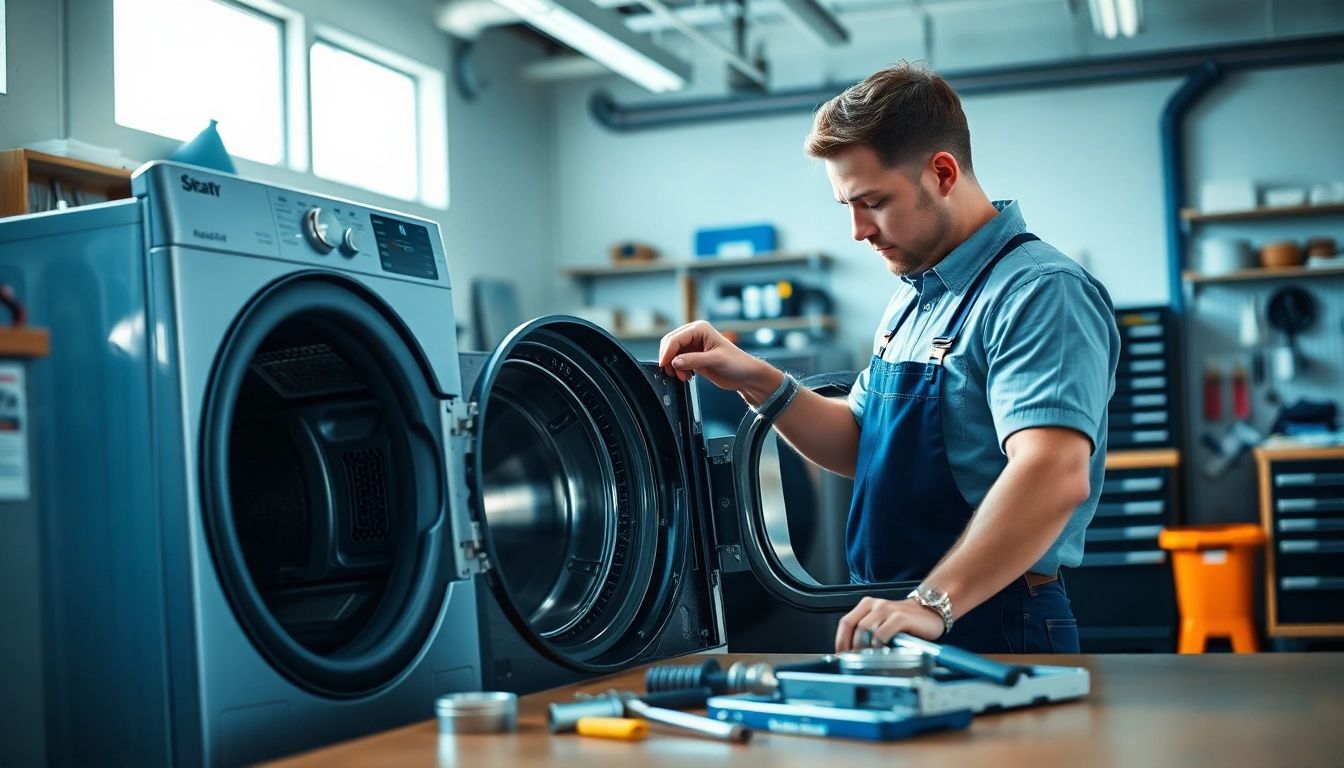Understanding Common Dryer Issues
1. Identifying Signs of Trouble
Dryers are essential appliances in many households, providing convenience and efficiency in drying laundry. However, like any mechanical device, they can encounter issues over time. Recognizing the early signs of trouble can help prevent more significant problems down the line. Users should be aware of specific indicators that suggest a dryer is malfunctioning, such as:
- Clothes taking longer to dry than usual.
- Strange noises coming from the dryer, such as thumping or squeaking.
- The dryer not turning on at all.
- Excessive heat from the exterior of the dryer casing.
- Burning smells or odors during operation.
- Lint buildup in unusual areas, indicating possible blockages.
Being attentive to these signs can save homeowners from costly repairs or appliance replacements. If any of these issues are observed, consider seeking professional dryer repair halifax services.
2. Common Problems in Dryer Repair Halifax
Understanding the common problems associated with dryers can facilitate quicker resolutions. Here are some typical issues encountered by Halifax residents:
- Heating Issues: One of the most common problems is the dryer not producing heat. This could be due to a defective heating element, thermostat issues, or blown fuses.
- Drum Not Turning: A malfunctioning belt or motor could be responsible for a drum that doesn’t turn, indicative of mechanical failure.
- Noise Problems: Unusual sounds usually indicate wear or defects in components like the belt, bearing, or rollers.
- Venting Issues: Clogged vents can lead to overheating, increased drying times, and even fire hazards.
- Faulty Controls: Problems with the control board or timer can prevent the dryer from functioning as intended.
It’s crucial to address these issues promptly to maintain both safety and efficiency.
3. Safety Concerns and Precautions
When dealing with appliance repair, safety should always be a priority. Here are some essential safety precautions to keep in mind while addressing dryer issues:
- Always unplug the dryer before performing any repairs to avoid electrical shock.
- Read the owner’s manual for specific instructions related to your dryer model.
- Ensure the work area is well-lit and free of flammable materials.
- Use appropriate tools and protective gear, such as gloves and safety glasses.
- If unsure about any step in the repair process, consult a professional.
By adhering to these safety guidelines, users can minimize hazards associated with dryer malfunctions.
DIY Troubleshooting Techniques
1. Step-by-Step Diagnosing Methods
For those interested in DIY repairs, understanding how to diagnose the problem is key. Here is a general approach to troubleshooting:
- Check Power Supply: Ensure the dryer is plugged in and there are no blown fuses or tripped breakers.
- Inspect the Door Switch: Verify that the door is closing properly and the door switch is functional, as the dryer won’t operate if the door is ajar.
- Test Settings: Make sure the correct drying cycle is set and that the timer is functioning.
- Clear Vent Debris: Examine and clean the lint filter and venting system to eliminate blockages.
- Listen for Sounds: Identify any unusual noises that can provide clues to specific issues.
This systematic approach can help pinpoint the problem and determine if a DIY solution is viable or if professional intervention is necessary.
2. When to Seek Professional Help
While many minor problems can be handled with DIY repairs, certain issues require the expertise of a professional. Seek help for the following situations:
- If the dryer does not start after checking power supply and controls.
- When mechanical issues are suspected, such as motor failure or broken drum belts.
- If there are signs of electrical malfunction, such as burnt wiring or frequent tripping of circuit breakers.
- When attempting repairs with which you feel uncomfortable or unqualified.
- For persistent issues that continue even after basic troubleshooting steps have been applied.
Recognizing the limits of DIY can prevent further damage and ensure a safer, more efficient repair process.
3. Tools Needed for Repairs
Having the right tools on hand is essential when performing dryer repairs. Here’s a list of basic tools that can help ease the process:
- Multimeter: For testing electrical components and ensuring they are functioning properly.
- Screwdrivers: Both Phillips and flathead screwdrivers are essential for opening panels and securing parts.
- Pliers: Useful for gripping, twisting, and cutting wires and other components.
- Socket Set: For removing and fastening bolts and nuts.
- Tweezers: Handy for retrieving small objects or lint from hard-to-reach areas.
- Vacuum Cleaner: An important tool for cleaning lint buildup inside the dryer and venting system.
These tools can make the repair process smoother and more efficient, empowering homeowners to address issues confidently.
Maintenance Practices for Longevity
1. Regular Cleaning and Inspection
Routine maintenance is vital for keeping a dryer in good working order. Here are some essential practices:
- Clean the Lint Filter: After every load, remove lint from the filter to prevent clogs and fire hazards.
- Inspect Vents: Regularly check and clean the venting system to ensure proper airflow and efficiency.
- Deep Clean the Dryer: Periodically, disconnect the dryer and clean the interior and exterior with a soft cloth or vacuum.
- Test Safety Features: Periodically verify that the door switch and thermal fuse are functional.
Establishing a cleaning schedule can extend the life of the appliance and maintain its performance.
2. Understanding Dryer Settings and Functions
Understanding dryer settings can optimize drying efficiency. Here are some key functions that every user should know about:
- Tumble Dry: The standard drying cycle that uses tumbling and heat to dry clothes.
- Air Dry or No Heat: This setting is perfect for delicates that cannot withstand high heat.
- Sensor Dry: A feature that uses moisture sensors to adjust drying time, ensuring clothes don’t over-dry.
- Permanent Press: This setting reduces wrinkles through a cool-down cycle at the end of drying.
Familiarity with these settings can lead to better care of clothing and more efficient appliance operation.
3. Tips for Efficient Usage
Maximizing dryer efficiency can lower energy costs and enhance performance. Consider these tips:
- Do Full Loads: Ensure the dryer is full (but not overloaded) to maximize efficiency.
- Mix Fabrics: Avoid drying heavy towels with lighter fabrics, as they dry at different rates.
- Check Load Size: Adjust drying time based on load size for optimal results.
- Use Dryer Balls: These can help separate clothes and improve airflow during drying.
Following these practical usage tips can lead to enhanced performance and energy savings.
Selecting the Right Repair Service
1. Evaluating Service Quality
When the need arises for professional help, choosing the right repair service is crucial. Consider the quality indicators of potential service providers:
- Experience: Look for technicians with a solid background in appliance repair, specifically with your dryer’s brand.
- Certifications: Verify if the technicians carry necessary certifications and training in appliance repair.
- Warranty on Repairs: Services that guarantee their work with a warranty demonstrate confidence in their repair quality.
Being thorough in evaluating these criteria can lead to better service outcomes and customer satisfaction.
2. Questions to Ask Repair Technicians
Inquiring about specific aspects of repair service can provide critical insights, including:
- What is the estimated cost of the repair?
- Can they provide a breakdown of repair charges?
- How long will the repair take?
- Are replacement parts OEM (original equipment manufacturer) or generic?
- What are their policies regarding warranties on parts and labor?
Asking the right questions can ensure transparency and help avoid unexpected costs.
3. Importance of Customer Reviews
Before hiring a repair technician, it’s advisable to check customer reviews and ratings. Reviews can highlight several aspects:
- Customer satisfaction levels and likelihood of recommending the service.
- Common issues faced by past customers and how they were resolved.
- Overall responsiveness and professionalism of the service team.
Researching online reviews can provide valuable insights, ultimately leading to a more informed decision regarding repair services.
Cost Factors in Dryer Repair Halifax
1. Typical Repair Costs Breakdown
The cost of dryer repair can vary widely based on numerous factors. Understanding what influences pricing can help in budgeting for repairs:
- Type of Repair: Simple issues like replacing a belt will cost less than major repairs, like replacing a heating element or electronic control board.
- Parts Required: The cost of replacement parts can vary; OEM parts are typically more expensive than aftermarket options.
- Service Call Fee: Most technicians charge a fee to assess the appliance, which may be waived if repairs are completed.
- Labor Costs: Hourly rates for repair services may vary based on the technician’s experience and geographical location.
Being informed about these factors can prepare homeowners for the potential costs associated with dryer repair.
2. Budgeting for Maintenance
In addition to emergency repairs, it’s wise to budget for regular maintenance. Here are some tips:
- Set Aside Funds: Establish a small monthly savings plan to cover potential future repairs.
- Schedule Routine Maintenance: Investing in regular check-ups can prevent larger issues and save money long-term.
- Monitor Performance: Keeping an eye on dryer efficiency can indicate when maintenance or repairs may be needed.
Effective budgeting can alleviate financial stress when appliance issues arise.
3. Understanding Warranties and Guarantees
Warranties can significantly influence repair costs. Understanding how to leverage them is key:
- Manufacturer’s Warranty: Check to see if your dryer is still under warranty, which may cover repairs for parts and labor.
- Service Guarantee: Look for repair services that offer guarantees on their work, giving you recourse if the issue reoccurs.
- Transferable Warranties: If you purchased a used appliance, find out if any warranties are still valid and transferable, which could save you money.
Being proactive about understanding and utilizing warranties can result in significant savings over time.













Leave a Reply